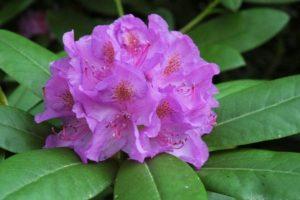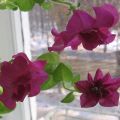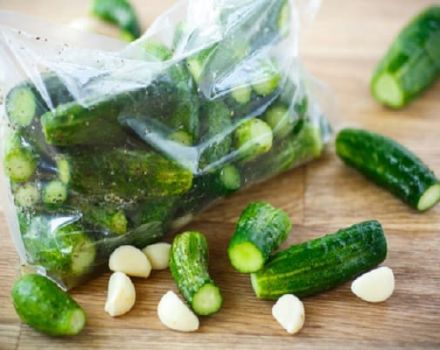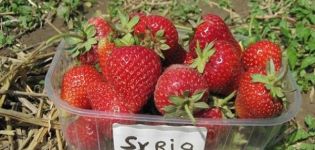Selection of verbena varieties, cultivation, planting and care in the open field
A blooming personal plot attracts the attention of others and pleases the eye. Among the variety of flowers, gardeners most often prefer varieties that have a long flowering period. The cultivation of verbena has become widespread, planting and caring for which does not create difficulties for gardeners, respectively, its popularity as an ornamental culture is growing.
Description and characteristics of the plant
The plant belongs to the Verbenov family, origin - South America. Belongs to the category of perennials, but is widely cultivated as an annual. The most commonly used hybrid plant variety, reaching a height of 25 cm, branched, has the ability to creep.
The hybrid representative has small flowers with a variety of colors. They form an inflorescence. The plant blooms from the beginning of summer to autumn. Verbena tolerates a cold snap well, even small frosts down to -3 aboutFROM.
The advantage of this plant over others is flowering for a long period, excellent indicators of seed germination even after long storage.
Popular varieties of verbena
There are two groups of verbena:
- Large-flowered - characterized by straight-growing branches reaching 45 cm in height, or creeping. These include: Defiance - 0.3 m high, with red flowers; Julia - height 0.4 m, with purple flowers; Cardinal - height 0.4 m, bright red flowers; Etnu - 0.5 m high, red flowers with a light eye.
- Compact - a recumbent representative with rising stem tips. These include: Amethyst - 0.3 mm high, with blue flowers; Disler - 0.25 m high, with red flowers; Crystal - 0.2 m high, with white flowers; Splendor - 0.2 m high, with purple flowers that have a purple hue.

This plant has gained popularity due to its unpretentiousness and beautiful appearance for a long time. The most popular varieties among gardeners:
- Canadian is a perennial variety that blooms until October under favorable climatic conditions. It grows in height up to 0.2 m. It is characterized by an openwork form of leaf plates, the most delicate color range of inflorescences (white, pink, with a lilac tint).
- Hard - cultivated as an annual, although this species is referred to as perennial. Violet colors prevail. On the branches there are rigid, oblong-shaped leaf plates.
- Buenos Aires - ranked among the tall varieties of vervain, reaches a meter in height. The shrub is perennial, gives many side branches, on which serrated thin leaf plates are located.
- Hybrid - derived from several views. It can reach a height of 0.5 m, it gives many side shoots. The leaf plates resemble a triangle. The main advantage is the variety of colors. There are no less than thirty shades, from light pink to dark lilac, violet and blue.
Features of growing a flower
This decorative culture is cultivated not only in open areas, but also in special containers. For example, such a species as ampelous grows freely in pots for decorating terraces, greenhouses and balconies. It is cultivated as an annual plant, as it does not tolerate frosty winters.
Verbena stratification
Verbena is mainly propagated by seed. Some of its varieties have seeds covered with a sufficiently strong shell, which impedes the process of swelling and germination. In such cases, stratification helps - cold temperature treatment. For stratification it is necessary:
- lay the seeds on a cloth, cover, moisten;
- put the fabric in an opaque bag made of dense polyethylene;
- put in the refrigerator, in the storage compartment for vegetables;
- withstand 4-5 days.
Sowing verbena seedlings
Sowing seed is allowed in open ground. But the seedling method of plant cultivation is more reliable than the non-seedling method.
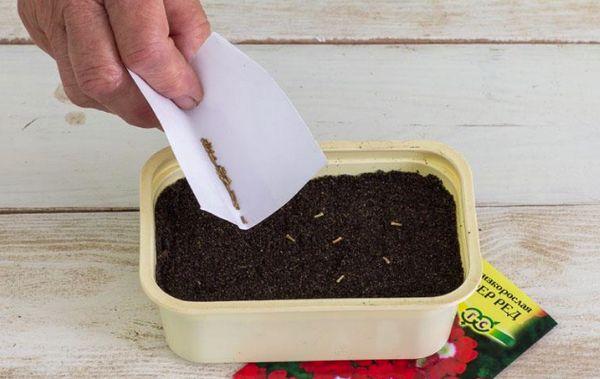
Seeds are able to maintain their germination capacity for 3 to 5 years. It is worth remembering that not everyone has a high germination rate. In a hybrid species, the percentage of germination is about 30, therefore, possible risks must be taken into account.
Sowing is carried out in the first days of the spring in containers with a light humus mass. Sprinkle the seeds with a light layer of earth mixed with humus, cover with glass. Put in a warm place. Germinate effectively and quickly at a temperature of +25 aboutC. Periodically ventilate, removing condensation accumulated on the glass. Seedlings will appear on the 25-30th day. After the seedlings must be placed in cool conditions, + 18-20 aboutFROM.
Verbena seedlings
Seedling material care mainly involves maintaining the necessary moisture balance. Verbena sprouts are irrigated when the soil dries up. After 25-30 days, when two pairs of leaves are formed, the verbena is dived into a special container or separate pots.
After 14 days after adaptation, it is necessary to feed with a complex of mineral fertilizers. The upper part of the ampel verbena varieties must be pinched to enhance the tillering process. This does not apply to the undersized varieties, since they have good branching ability.

When and how to plant vervain
Verbena seedlings are planted on open beds after a stable heat is established.Short cooling down to -3about The plant will survive. But a long stay in the cold will be disastrous for him or bring irreparable damage.
The plant is unpretentious to the place of growth, but it develops and blooms better in areas that are sufficiently lit and sunny. Verbena will not be damaged by direct rays. The culture prefers fertile loamy soil, but it feels relatively well in heavy soils if lightened with sand.
Vervain is planted according to the following rules:
- the distance between compact species is 0.2 m, between creeping ones at least 0.3 m;
- before planting, it is necessary to lay drainage in the prepared hole: crushed brick, gravel, in order to prevent water stagnation in the root system;
- water the hole, wait until the liquid is absorbed;
- plant verbena with a root ball;
- sprinkle with soil, lightly press down.
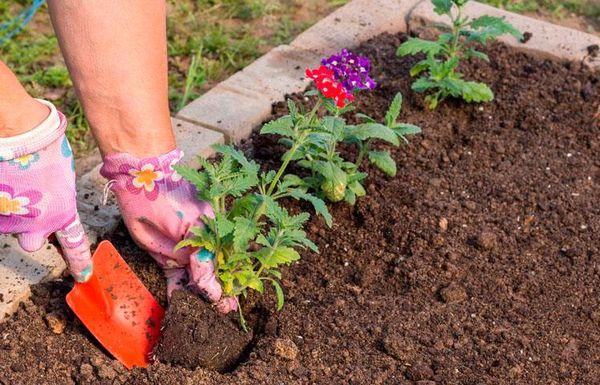
How to care for vervain
Verbena is not capricious, even with minimal effort it grows beautifully and pleases with color.
Fertilization and watering
After planting the plant, watering is done more often, gradually decreasing. It is irrigated in moderation as the soil dries up. Lack and excessive moisture negatively affects the culture.
The plant is nourished with mineral fertilizers 4 times during the season. It is recommended to use organic matter, a one-time feeding is enough. Excessive nutrition will not be beneficial: instead of abundant flowering, there is a risk of overgrowing.
Wintering
Winter is not a good time for verbena. This perennial culture grows in our latitudes as an annual one. At the end of flowering and fruiting, it is removed. Although, if you wish, you can try to save it until next summer season. Such a plant will begin to bush earlier and bloom faster.

For wintering verbena you need:
- in early November, carefully dig up the plant;
- place in a closed room with a temperature regime of no more than +15 aboutFROM;
- if new branches are growing and flowering, the inflorescences must be removed, the shoots must be shortened;
- prune in early spring, then plant in the ground.
Verbena pests and diseases
The main pest of the plant is the mining fly. They destroy most of the green part of the culture. As a result, the metabolic processes in verbena are disrupted, it dies. For destruction, it is necessary to treat the plant with chemicals.
Compliance with the elementary rules of care will ensure healthy development of the plant, if the conditions of maintenance are violated, the plant immediately shows this.
With abundant watering, rotting of the root or stem occurs, the verbena leaf plate acquires a purple hue. Further, powdery mildew is affected. To eliminate the problem, you need to remove the affected leaf plates, reduce the number of waterings and their volume, treat the plant with special insecticidal agents.
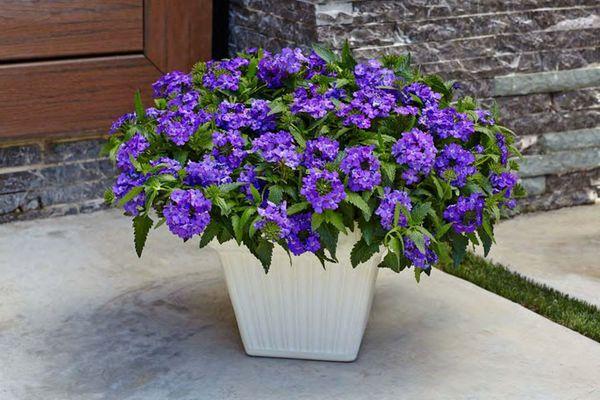
Flower cultivation
Even an inexperienced gardener can propagate with seed. The beginning of spring is the most favorable seeding time. In winter, germination is extremely slow, and with the onset of spring, shoots can be seen in 10-15 days.
How to harvest seeds correctly? After the flowers wither, fruits are formed, similar to nuts. When fully ripe, they break up into 4 slices. Harvesting is done when the seed boxes are dry and brown.
Before sowing, it is necessary to calibrate the seeds: weed out small, damaged and suspicious ones.
After that, it is important to carry out disinfection by placing the selected seeds in a 1% manganese solution for half an hour. Then rinse with cold boiled water.
When growing verbena from seeds, in addition to stratification, it is recommended to soak and keep them in a growth stimulator. Used "Zircon", "Kornevin", "Heteroauxin". If you sow seeds in a separate container, you will not need to dive.
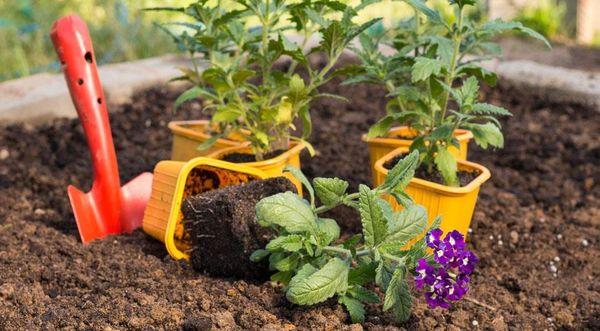
Reproduction of verbena by cuttings begins in the fall. Before freezing, remove the shrub from the ground, capturing the root ball. Put in a basement, on a balcony or in another outbuilding with a temperature of +10 aboutFROM.
In spring, cuttings are made, the best cuttings are obtained from the cut tops of the shoots. The stalk should have 4-5 pairs of leaf plates. The cut must be sprinkled with charcoal powder. Leave the leaves on the top, pinch off the rest. For grafting, a mixture of peat and sand is mainly used, planting is done shallowly, to the place where the leaves were torn off. The container is covered with polyethylene to ensure a constant moisture level. Well-formed roots are formed after 25-30 days.
Application in landscape design
Among perennial varieties, medicinal verbena is distinguished.But most often, verbena is cultivated as an ornamental plant, widely used in landscape design. In addition, florists love to use it in bouquets. And landscape decoration specialists use it when decorating in tandem with other flowering plants. It is also grown in flower pots, effectively decorating loggias, open terraces and summer pavilions.
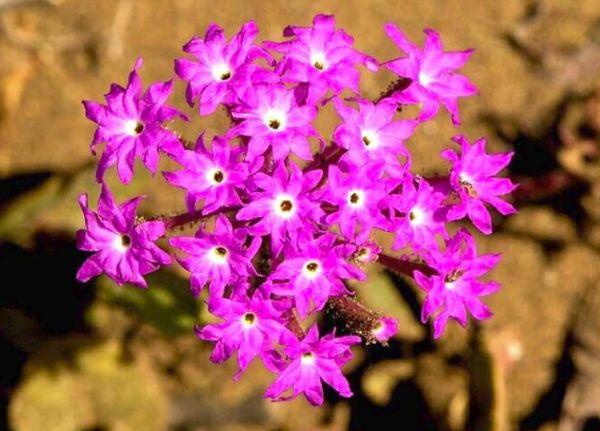
The popularity of vervain is given by the presence of a varied color assortment; it goes well with any flowering plants: wildflowers and exotic representatives.
What problems can you face?
Verbena is recognized as an undemanding plant. But this should not be neglected. There are several nuances that you need to pay attention to when disembarking and leaving:
- The soil should be moderately moist. Excessive moisture will lead to root rot and the development of fungal diseases.
- There is no need for additional irrigation of the flower.
- Regular weeding is required. The weed grasses the nutrients from the soil, which causes the plant to stop setting new buds.
- With an excess of nitrogen, verbena may stop blooming. In this case, new unnecessary shoots will appear, weakening the plant.
- For long-term abundant flowering, the shrub must be cut by 1/3 part after the first flowering phase. Further pruning of the verbena is unnecessary.
- It is important to remove wilted peduncles in time so that the plant throws out new inflorescences.
Subject to the simple rules for planting and leaving, verbena will delight you with an abundance of violent colors all summer.

